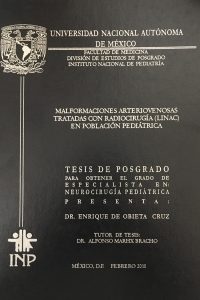Tesis de neurocirugía pediátrica
Las malformaciones arteriovenosas cerebrales (MAVS) son lesiones que se definen por la presencia de cortocircuitos arteriovenosos a través de un nido de conexiones vasculares tortuosas y enrolladas, que conectan arterias con venas de drenaje. El tratamiento de las malformaciones arteriovenosas es multidisciplinario tanto en la población adulta como en la pediátrica, el cual puede ser mediante microcirugía, embolización y más recientemente la radiocirugia, que es el tratamiento de elección cuando el nido de la malformación es profundo y se encuentra en áreas elocuentes. La radiocirugia es un tratamiento seguro y eficaz para tratar malformaciones arteriovenosas en la población pediátrica.14 En el presente estudio se analizaron 27 pacientes con el diagnostico de malformación arteriovenosa, diagnosticados por el servicio de Neurocirugía del INP, quienes eran candidatos a tratamiento con radiocirugía y fueron referidos al INNN para recibir dicho procedimiento, 4 de ellos con un tratamiento multifraccionado (DF) debido a volúmenes de la malformación muy grandes, con un volumen medio de 32 cm3, los otros 23 pacientes recibieron dosis única (DU), 16 (69.57%) de ellos fueron del género femenino y 7 (30.43%) del masculino, con una edad media de 13 años, mediana de 14 y un rango de 5 a 17 años. El volumen medio de las MAVS fue de 4.02 cm3, con una mediana de 3.04 cm3 y un rango de 0.36- 15 cm3. Utilizamos un punto de corte de 4 cm3 para el análisis inferencia!. La obliteración se documentó en el 61% de los casos, encontrando que los factores que se asocian a la oclusión son el volumen (OR 15; IC 95% 1.83 – 122. 7, X2 6.14, p = 0.013), el RBAS y el RBAS modificado (OR 16.25; IC 95% 1.99- 132.3, X2 6.65, p = 0.010) y la dosis presento los siguientes resultados (OR 0.133; IC 95% 0.021 -0.842, X2 4.41. p = o.o36)
Cerebral arteriovenous malformations (AVMV) are lesions that are defined by Presence of arteriovenous short circuits through a nest of vascular connections Tortuous and coiled, connecting arteries with drainage veins. The treatment of arteriovenous malformations is multidisciplinary both in the Adult population as in the pediatric, which can be through microsurgery, Embolization and more recently the radiosurgery, which is the treatment of choice When the nest of the malformation is deep and lies in eloquent areas. The Radiosurgery is a safe and effective treatment for arteriovenous malformations In the pediatric population.14 In the present study we analyzed 27 patients with the diagnosis of malformation Arteriovenous, diagnosed by the INP’s Neurosurgery department, who were Candidates for treatment with radiosurgery and were referred to the INNN to receive said Procedure, 4 of them with a multifraction treatment (DF) due to volumes of The malformation very large, with an average volume of 32 cm3, the other 23 patients Received a single dose (DU), 16 (69.57%) of them were female and 7 (30.43%) of the male, with a mean age of 13 years, median of 14 and a range of 5 To 17 years. MAVS mean volume was 4.02 cm3, with a median of 3.04 Cm3 and a range of 0.36-15 cm3. We used a cutoff point of 4 cm3 for the analysis inference!. The obliteration was documented in 61% of the cases, finding that the Factors associated with occlusion are volume (OR 15, 95% CI 1.83 – 122.7, X2 6.14, p = 0.013), the RBAS and the modified RBAS (OR 16.25, 95% CI 1.99-132.3, X2.66, P = 0.010) and the dose presented the following results (OR 0.133, 95% CI 0.021 -0.842, X2 4.41. P = o.o36)

